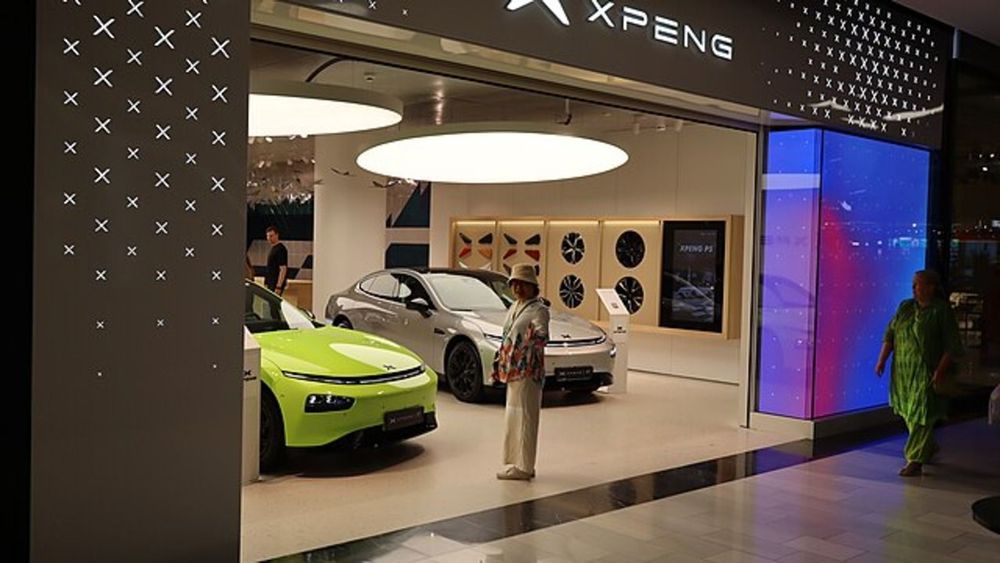Advertisement|Remove ads.
China’s Auto Boom Faces A 2026 Slowdown Warning — Can XPeng, Baidu, WeRide, And Pony.ai Deliver The Robotaxi Breakout?

- Deutsche Bank expects China’s auto market to weaken in 2026 as policy shifts pull demand forward and pressure margins across major automakers.
- Chinese automakers are accelerating fully driverless programs for 2026, pushing toward mass-market robotaxis and early commercial deployments.
- HSBC Research said autonomous tech and physical AI could still deliver an industry inflection point.
China’s auto industry is heading into a potentially difficult year in 2026, as analysts warn that weaker vehicle volumes and shrinking margins could pressure the world’s largest car market. However, the country’s leading autonomous-driving companies, Xpeng, Baidu, WeRide, and Pony.ai,, are accelerating toward mass deployment of robotaxis and early-stage physical AI.
Deutsche Bank Flags 2026 Downturn Risks
Deutsche Bank analyst Bin Wang said in a note that he expects softer auto sales growth in the first quarter of 2026 as buyers bring purchases forward into late 2025 ahead of policy changes. Those include the expected reduction of trade-in subsidies and the planned introduction of a new purchase tax for new-energy vehicles, according to a report by The Wall Street Journal.
Wang said sector-wide margins are likely to come under pressure next year as some automakers absorb the cost of policy shifts. He also highlighted a potential offsetting factor in the second half of 2026: the possibility of a tax reduction for internal combustion engine vehicles, which could help support demand, margins, and investor sentiment.
But even as the traditional momentum softens, China’s autonomous-driving sector is gaining traction.
HSBC Sees Autonomous Driving Near A Demand ‘Inflection Point’
In contrast to near-term pressure, HSBC Global Research said rapid commercialization of autonomous driving and early robotics is building momentum across China’s auto and mobility markets. Robotaxis are entering early commercialization, and robotics is showing signs of initial mass production, pointing to developments the firm says could mark a longer-term demand inflection point as regulations evolve, consumer adoption improves, and major players advance toward key milestones.
Chinese Players Race Toward 2026 Driverless Deployment
Chinese companies are aggressively preparing for large-scale driverless fleets beginning in 2026. XPeng plans to roll out three mass-produced Level 4 robotaxi models next year, using its proprietary “AI Driver” system powered by four in-house Turing chips delivering up to 3,000 TOPS of compute. The company has partnered with Alibaba’s Amap to integrate real-time traffic and navigation data and operate robotaxis without relying on traditional high-definition maps.
Baidu’s Apollo Go already operates more than 1,000 fully driverless robotaxis across 15 cities, including Beijing, Wuhan, and Chongqing, and has completed over 11 million rides. The company plans international expansion, with fully driverless services scheduled for Dubai, Germany, and the U.K. in 2026.
WeRide continues to run a fully driverless service in Guangzhou, while Pony.ai operates autonomous fleets in Shenzhen and Beijing and aims to grow to 1,000 vehicles by year-end. Backed by Toyota, Pony.ai has secured partnerships to bring driverless services to Dubai and Qatar.
Pony.ai said China is closing the technology gap with U.S. competitors, citing the country’s lower-cost sensor supply chain and deep engineering talent pool.
Tesla Seeks Full Approval For FSD In China
Tesla is also intensifying its push in China. CEO Elon Musk recently said regulators indicated the company could receive full approval for its Full Self-Driving system by February or March 2026. Tesla currently has partial permissions to conduct limited public trials.
Xpeng And Baidu Lead Bullish Chatter On Stocktwits
On Stocktwits, retail sentiment was ‘bullish’ for XPeng (XPEV) and Baidu (BIDU), while it was ‘bearish’ for Pony.ai (PONY), WeRide (WRD) and Tesla (TSLA). Message volume was ‘extremely high’ for Baidu, ‘high’ for XPeng, ‘normal’ for Pony.ai and WeRide, and ‘low’ for Tesla.
So far this year, U.S.-listed shares of XPEV are up 70%, BIDU is up 31%, WRD is down 50%, and PONY is down 21%, while TSLA has slipped 2%.
For updates and corrections, email newsroom[at]stocktwits[dot]com.











/filters:format(webp)https://news.stocktwits-cdn.com/large_Getty_Images_2247687123_jpg_6a66f2327c.webp)
/filters:format(webp)https://news.stocktwits-cdn.com/Aashika_Suresh_Profile_Picture_jpg_2acd6f446c.webp)
/filters:format(webp)https://news.stocktwits-cdn.com/large_Lululemon_jpg_9867862241.webp)
/filters:format(webp)https://news.stocktwits-cdn.com/IMG_4530_jpeg_a09abb56e6.webp)
/filters:format(webp)https://st-everywhere-cms-prod.s3.us-east-1.amazonaws.com/large_lo_lo_Ce_Vj8l_PBJ_Sc_unsplash_1_098657dd27.jpg)
/filters:format(webp)https://news.stocktwits-cdn.com/large_tesla_elon_musk_jpg_e4b2d89a54.webp)
/filters:format(webp)https://st-everywhere-cms-prod.s3.us-east-1.amazonaws.com/Rounak_Author_Image_7607005b05.png)
/filters:format(webp)https://news.stocktwits-cdn.com/large_Adobe_jpg_02bf913358.webp)
/filters:format(webp)https://st-everywhere-cms-prod.s3.us-east-1.amazonaws.com/shanthi_v2_compressed_98c13b83cf.png)
/filters:format(webp)https://news.stocktwits-cdn.com/large_Getty_Images_2250240977_jpg_5b777d96ef.webp)
/filters:format(webp)https://st-everywhere-cms-prod.s3.us-east-1.amazonaws.com/IMG_9209_1_d9c1acde92.jpeg)